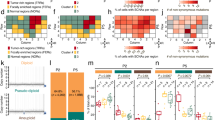Abstract
We combined laser-assisted microdissection from H&E-stained paraffin sections, degenerated oligonucleotide-primed polymerase chain reaction (DOP-PCR), and comparative genomic hybridization (CGH) to analyse chromosomal imbalances in small tumour areas consisting of 50–100 cells. This approach was used to investigate intratumour genetic heterogeneity in a case of metastatic prostatic adenocarcinoma and chromosomal changes in areas of prostatic intraepithelial neoplasia (PIN) adjacent to the invasive tumour. In four microdissected invasive tumour areas with different histological patterns (acinar, cribriform, papillary and solid) marked intratumour heterogeneity was found by CGH. Recurrent chromosomal imbalances detected in at least two microdissected tumour areas were gains on 1p32→p36, 2p22, 3q21, 7, 8q21→q24, 11q12→q13, 16p12→p13, 17, 19 and loss on 16q23. Additional chromosomal changes were found in only one of the microdissected areas (gains on 16q21→q23, 20q22 and losses on 8p21→p23, 12p11→q12, 12q21→q26, 13q21→q34, 16q12, and 18q22). In PIN, gains on chromosomes 8q21→q24 and 17 were found in both samples investigated (low and high grade PIN), while gains on chromosomes 7, 11q, 12q, 16p, and 20q and losses on 2p, 8p21→p23, 12q were found only in one PIN area. Controls to ensure reliable CGH results consisted in CGH analyses of (i) approximately 80 microdissected normal epithelial cells, which showed no aberrations after DOP-PCR and (ii) larger cell numbers (approximately 105 or 107 cells) of the primary tumour investigated without DOP-PCR and partially displaying the chromosomal imbalances (gain on 16p12→p13, losses on 2p25, 8p21→p23, 12p11→p12, 12q21→q26, 18q22) found in the small microdissected areas. Microsatellite and FISH analyses further confirmed our CGH results from microdissected cells. The combined approach of laser-assisted microdissection, DOP-PCR and CGH is suitable to identify early genetic changes in PIN and chromosomal imbalances associated with the particular histological patterns of invasive prostatic adenocarcinoma.
Similar content being viewed by others
Author information
Authors and Affiliations
Additional information
Received: 30 January 1998 / Accepted: 25 May 1998
Rights and permissions
About this article
Cite this article
Zitzelsberger, H., Kulka, U., Lehmann, L. et al. Genetic heterogeneity in a prostatic carcinoma and associated prostatic intraepithelial neoplasia as demonstrated by combined use of laser-microdissection, degenerate oligonucleotide primed PCR and comparative genomic hybridization. Virchows Archiv 433, 297–304 (1998). https://doi.org/10.1007/s004280050252
Issue Date:
DOI: https://doi.org/10.1007/s004280050252




